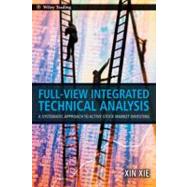
What is included with this book?
| Preface | p. ix |
| The Need for a Full View Integrated Approach | p. 1 |
| The Motivation | p. 1 |
| The Need for a New Paradigm | p. 1 |
| The Answers from FVITA | p. 4 |
| The Necessity of FVITA | p. 6 |
| Random Walk? | p. 9 |
| Two Basic Elements of Market Dynamics | p. 11 |
| Oscillators-An Overview | p. 11 |
| The Oscillator of Choice-Stochastics | p. 19 |
| Trend Indicator-Moving Average | p. 21 |
| Trend Indicator-Moving Average Convergence/Divergence | p. 24 |
| Adaptive Trend Indicators | p. 29 |
| Kaufman's Adaptive Moving Average | p. 30 |
| Chande's Variable Index Dynamic Average | p. 31 |
| Mart's Master Trading Formula | p. 31 |
| Adaptive Oscillators | p. 33 |
| Other Tools of Technical Analysis | p. 33 |
| Multi-Screen Systems | p. 35 |
| The Need for Multi-Screen Approaches | p. 35 |
| Triple Screens | p. 37 |
| Extended Interval Charts in FVITA-Daily and Up | p. 39 |
| Intra-Day Interval Charts in FVITA | p. 45 |
| Bounded, Interval-Specific Bull and Bear Markets | p. 49 |
| Interval-Specific Bull and Bear Market I-Concept | p. 49 |
| Interval-Specific Bull and Bear Market II-Criteria | p. 52 |
| Interval-Specific Bull and Bear Market III-Limits of Countermovements | p. 57 |
| Triple Screen System Under Full View | p. 66 |
| Market Turning Points and Duration of Pauses | p. 69 |
| Support and Resistance | p. 69 |
| Bollinger Bands | p. 74 |
| Waves | p. 78 |
| Turning Points after Eight and R9 Observations | p. 85 |
| Thrust | p. 86 |
| Type I, II, and III Pauses | p. 91 |
| Trend Reversals vs. Temporary Countertrends | p. 101 |
| Trend Reversals | p. 101 |
| Without the Two-Day Chart | p. 108 |
| Running Space after Trend Reversal | p. 109 |
| Temporary Countertrends | p. 111 |
| Straight Pauses | p. 122 |
| Exception 1: Composite Bottoming-Up and Composite Topping-Off | p. 128 |
| Exception 2: Approaching the Turning Point | p. 130 |
| Relationship between Low- and High-Order Signals | p. 132 |
| Trading Strategies on Trend Signals | p. 134 |
| Pauses Under Different Market Conditions | p. 141 |
| Pausing-Down from a Historical New High | p. 142 |
| Pauses Against Temporary Trends | p. 145 |
| Trading Strategies for Pauses | p. 151 |
| Case Studies | p. 157 |
| Case 1: The 2007 Financial Market Crisis-DJIA | p. 158 |
| Case 2: The 2000 High-Tech Bubble and its Aftermath-DJIA | p. 162 |
| The Formation of the High-Tech Bubble-DJIA | p. 163 |
| The Bursting of the High-Tech Bubble-DJIA | p. 167 |
| Case 3: The 1990 Bubble and Fall-Topix | p. 172 |
| The Formation of the 1990 Bubble-Topix | p. 172 |
| The Bursting of the Bubble in 1990, I-Topix | p. 177 |
| The Bursting of the Bubble in 1990, II-Topix | p. 183 |
| Case 4: The 2003 Rebound and 2007 Crash | p. 187 |
| The Rebound in 2003-Topix | p. 187 |
| The Fall after the Crash in 2007-Topix | p. 192 |
| Case 5: The 2007 Crash-Shanghai Composite Index | p. 195 |
| Market at the Turning Point-Shanghai Composite Index 2007 | p. 195 |
| The Crash of 2007-Shanghai Composite Index | p. 201 |
| Random Walk, Efficient Market vs. Market Activism | p. 207 |
| Efficient Market Hypothesis-The Roots | p. 208 |
| Efficient Market Hypothesis-The Evidence | p. 212 |
| EMH, Market Activism and the $100 Bill Story | p. 216 |
| Flawed Empirical Observations Against Market Activism | p. 217 |
| A Fund to Show Effective Market Activision | p. 224 |
| A Theoretical Argument for Technical Analysis | p. 228 |
| Integrating Macro, Fundamental, Quantitative and Technical Analysis | p. 237 |
| The Fragmented State of Market Analysis | p. 237 |
| Integrating Different Technical Analyses Under FVITA | p. 239 |
| Macroeconomic Analysis and FVITA | p. 240 |
| Integrated Approach to News Processing | p. 241 |
| Integrated Analysis of Bubbles and Panics | p. 244 |
| Firm Fundamentals and FVITA | p. 248 |
| Options and FVITA | p. 249 |
| Other Issues | p. 253 |
| Statistical Analysis | p. 253 |
| Technical Analysis as Public Knowledge | p. 255 |
| Concluding Remarks | p. 259 |
| Glossary | p. 261 |
| References | p. 265 |
| Index | p. 267 |
| Table of Contents provided by Ingram. All Rights Reserved. |
The New copy of this book will include any supplemental materials advertised. Please check the title of the book to determine if it should include any access cards, study guides, lab manuals, CDs, etc.
The Used, Rental and eBook copies of this book are not guaranteed to include any supplemental materials. Typically, only the book itself is included. This is true even if the title states it includes any access cards, study guides, lab manuals, CDs, etc.